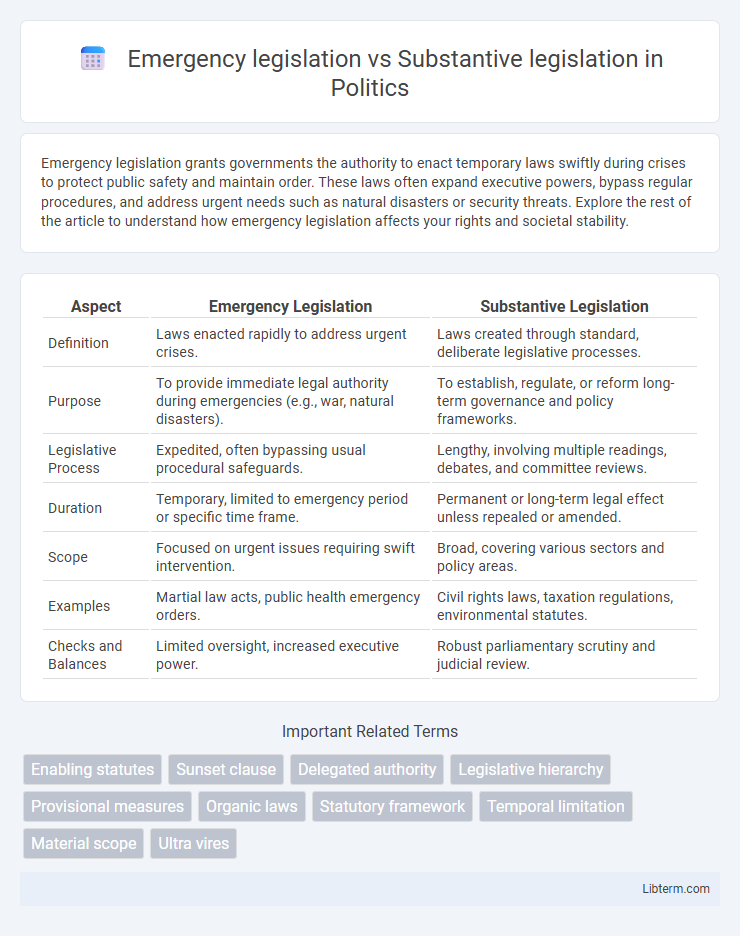Emergency legislation grants governments the authority to enact temporary laws swiftly during crises to protect public safety and maintain order. These laws often expand executive powers, bypass regular procedures, and address urgent needs such as natural disasters or security threats. Explore the rest of the article to understand how emergency legislation affects your rights and societal stability.
Table of Comparison
| Aspect | Emergency Legislation | Substantive Legislation |
|---|---|---|
| Definition | Laws enacted rapidly to address urgent crises. | Laws created through standard, deliberate legislative processes. |
| Purpose | To provide immediate legal authority during emergencies (e.g., war, natural disasters). | To establish, regulate, or reform long-term governance and policy frameworks. |
| Legislative Process | Expedited, often bypassing usual procedural safeguards. | Lengthy, involving multiple readings, debates, and committee reviews. |
| Duration | Temporary, limited to emergency period or specific time frame. | Permanent or long-term legal effect unless repealed or amended. |
| Scope | Focused on urgent issues requiring swift intervention. | Broad, covering various sectors and policy areas. |
| Examples | Martial law acts, public health emergency orders. | Civil rights laws, taxation regulations, environmental statutes. |
| Checks and Balances | Limited oversight, increased executive power. | Robust parliamentary scrutiny and judicial review. |
Understanding Emergency Legislation
Emergency legislation enables governments to swiftly enact laws during crises, prioritizing immediate public safety and order over standard procedural safeguards. It often grants expanded powers to authorities, bypassing usual legislative processes to address urgent threats such as natural disasters, pandemics, or security emergencies. Understanding emergency legislation involves recognizing its temporary nature and the balance between rapid response and protection of civil liberties.
Defining Substantive Legislation
Substantive legislation establishes the rights, duties, and legal principles governing individuals and entities, forming the core framework of law. It defines legal relationships, criminal offenses, and civil rights, determining what behavior is lawful or prohibited. Unlike emergency legislation, which is temporary and reactive, substantive legislation provides enduring legal standards essential for justice and social order.
Core Differences Between Emergency and Substantive Laws
Emergency legislation is designed for immediate response during crises, providing temporary powers to address urgent situations with expedited procedures and limited oversight. Substantive legislation establishes long-term legal frameworks governing rights, duties, and societal norms, subject to comprehensive debate and legislative scrutiny. The core difference lies in emergency laws' provisional nature and restricted scope versus substantive laws' permanence and broad regulatory impact.
Scope and Duration of Emergency Legislation
Emergency legislation typically has a limited scope focused on addressing immediate threats or crises, such as natural disasters, public health emergencies, or security threats, and is designed to grant temporary powers to authorities. Its duration is inherently short-term and often explicitly tied to the duration of the emergency, with automatic expiration or sunset clauses to prevent indefinite extension. In contrast, substantive legislation encompasses permanent or long-term laws that regulate ongoing societal functions and remain in force until amended or repealed by the legislature.
Legislative Process: Emergency vs Substantive
Emergency legislation is enacted rapidly to address urgent situations, often bypassing some procedural steps typical of substantive legislation, which undergoes a thorough and deliberate legislative process including multiple readings, committee reviews, and public consultations. The legislative process for emergency laws prioritizes immediate implementation and flexibility, while substantive legislation emphasizes detailed debate, stakeholder engagement, and long-term policy considerations. This distinction ensures that emergency statutes can be effective in crisis management, whereas substantive laws provide comprehensive frameworks for general governance.
Checks and Balances: Safeguarding Rights
Emergency legislation grants governments temporary powers to address crises, but these laws often face stringent checks and balances to prevent abuse and protect civil liberties. Substantive legislation, by contrast, undergoes comprehensive scrutiny through legislative processes, ensuring long-term rights and protections are enshrined with clear limitations on governmental authority. Independent judicial review and parliamentary oversight act as critical mechanisms to safeguard fundamental rights, maintaining a balance between urgent state actions and constitutional guarantees.
Real-World Examples of Emergency Legislation
Emergency legislation, such as the USA PATRIOT Act enacted after 9/11, enables swift government action to address immediate threats by temporarily expanding executive powers. Substantive legislation, exemplified by the Affordable Care Act, involves comprehensive policy changes that provide long-term legal frameworks beyond crisis responses. Real-world examples highlight how emergency laws prioritize rapid intervention during national security or health emergencies while substantive laws focus on stable, systematic reforms.
Impact on Civil Liberties and Social Order
Emergency legislation often expands government powers temporarily, potentially restricting civil liberties such as freedom of movement, assembly, and privacy to maintain social order during crises. Substantive legislation, in contrast, establishes long-term legal norms that balance civil liberties with social order, embedding protections within democratic frameworks. The impact on civil liberties is more pronounced and immediate under emergency laws, while substantive laws provide sustained governance and rights safeguards.
Challenges in Implementing Substantive Legislation
Implementing substantive legislation faces challenges such as ambiguity in legal language, inconsistent enforcement mechanisms, and resistance from stakeholders affected by regulatory changes. Complex administrative procedures and limited institutional capacity often hinder the effective application of these laws. Additionally, substantive laws require continuous updates to address evolving social and economic realities, complicating long-term compliance and enforcement efforts.
Long-term Implications for Legal Systems
Emergency legislation often grants temporary powers that bypass standard legal procedures, potentially setting precedents affecting future governance and civil liberties. Substantive legislation, being comprehensive and enduring, shapes the foundational legal framework and societal norms, influencing long-term policy development and judicial interpretation. The interplay between emergency and substantive laws can challenge legal stability, requiring careful balance to protect democratic principles while addressing urgent needs.
Emergency legislation Infographic

 libterm.com
libterm.com